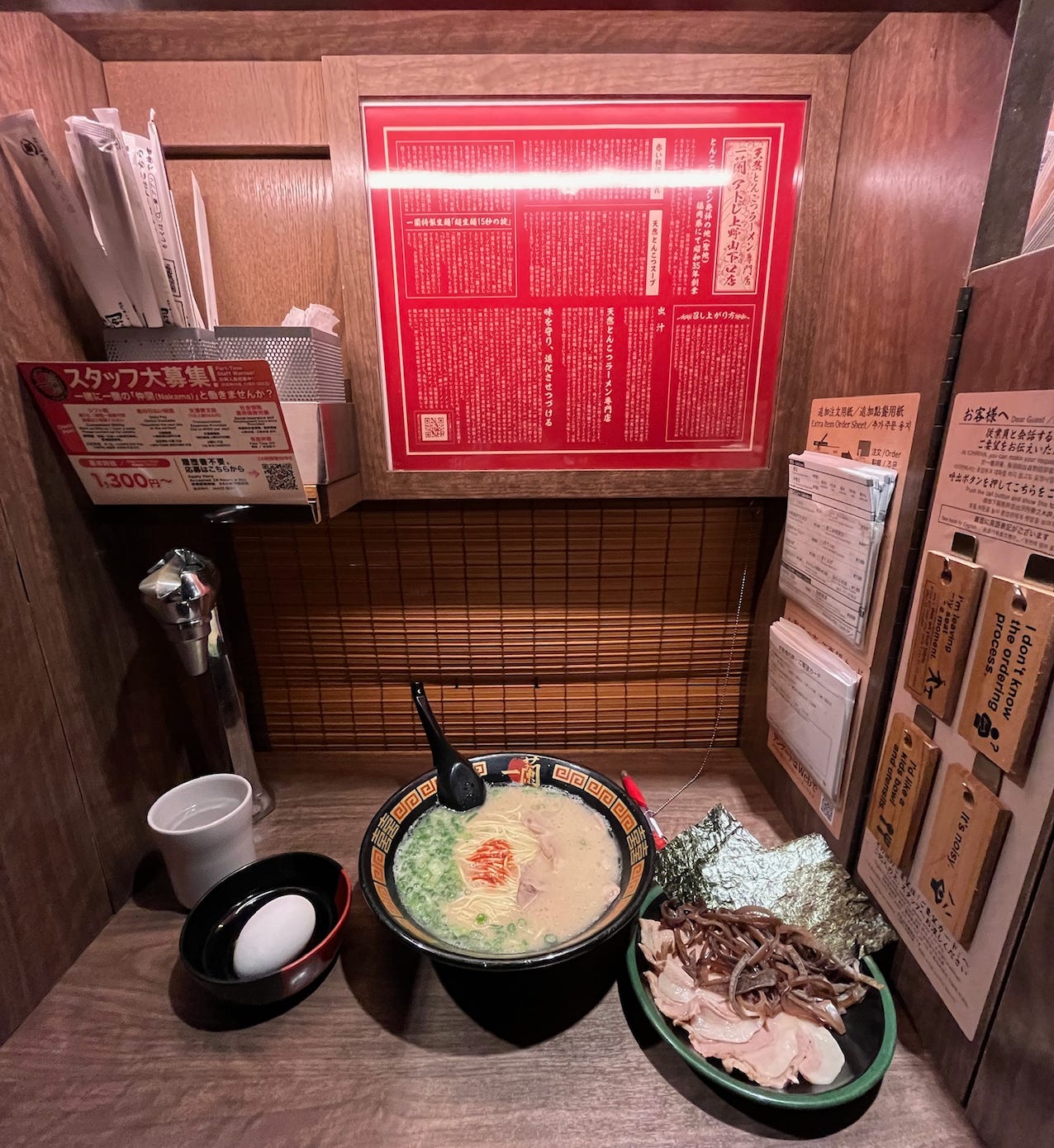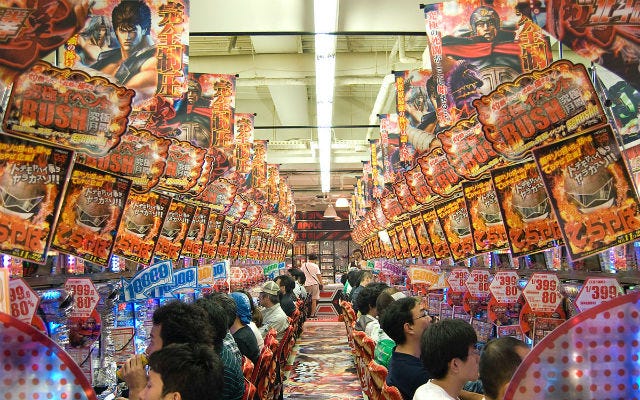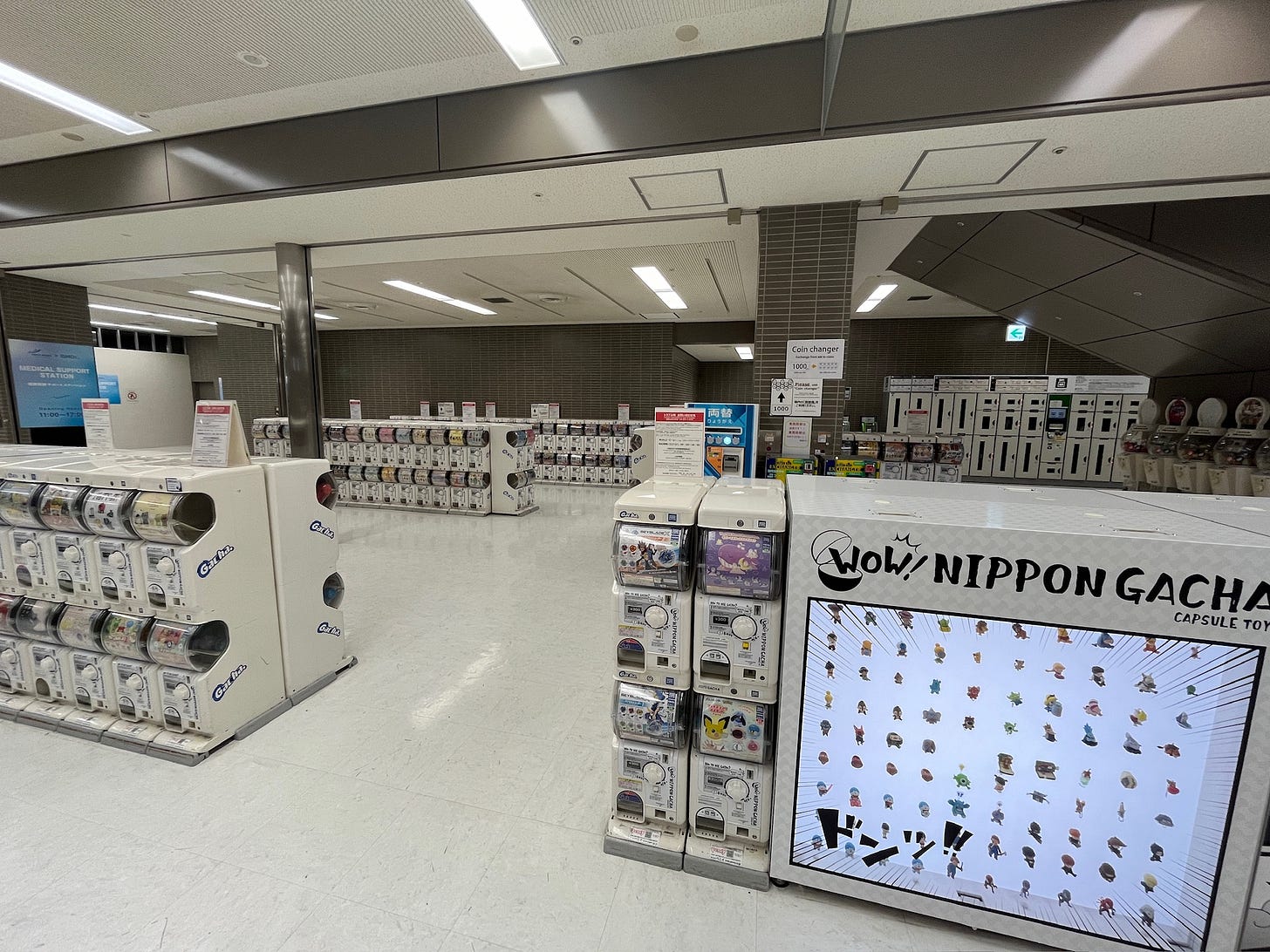I’m back from my honeymoon and the battle against jet lag has been won for the most part! It feels good to be back, staring at a blank page and filling it up with words.
To be honest, I was anxious about leaving for the honeymoon. It’s been ~5 years since I’ve traveled internationally and even longer since I’ve been to Asia. More importantly, would I be able to unplug from the 24/7 of crypto and web3? Would I be able to enjoy being in the present and refrain from looking at the charts?
For the most part, I was successful, especially when I was out and about during the day. I’m coming back refreshed and with a richer perspective on things.
Before we continue, I want to give a big THANK YOU to all the guest writers who contributed while I was out frolicking on my honeymoon. If you haven’t had a chance to read the guest pieces yet, check them out and click on a topic that interests you!
#288: Why Memecoins are Having Their Spotlight Moment by Kairon
#289: Web3 Marketing is Leaving a Lot on the Table by Jonathan Goodwin
#290: IRL Connectivity Is More Important Than Ever in Web3 by Lena Grundhoefer
#292: Why Web3 Loyalty Hasn’t Taken Off (Yet) by Tareq Nazlawy
#293: Gaming Trends in 2024 (So Far!) by members of the Brevan Howard Digital team
Despite being mentally, physically, and emotionally away from the happenings of the space, it was inevitable that I connected some of my honeymoon experiences to this industry. In short, something like this.
So what were some of these experiences and how do they tie into some themes in crypto and web3?
The JPY/USD exchange rate
Leading up to the trip, one thing my wife and I were aware of was that the US Dollar was strong compared to Japanese Yen. Like, really strong.
The 1 month USD/JPY chart doesn’t give us that much perspective. If we zoom out though…
Talk about good timing! As tourists in Japan from the US, my wife and I were fortunate to be on the side that was benefitting from this, remarking at how relatively affordable things were compared to back at home (eg: a $7 bowl of ramen in Japan that typically costs $20 before tax and tip and tastes way better). On the other hand, it encouraged me to think about the perspective from the other side. How does knowing about this (and seeing hordes of tourists visiting) impact Japanese residents who get paid in Yen and go about their daily lives, seeing that imported goods are getting more expensive rapidly?
I’m practically the opposite of an authority on these topics, but when you’re experiencing this IRL, it hits hard and makes you wonder what role crypto and stablecoins have in situations like these. More extreme examples of this are Argentina and the Argentine Peso.
Digital art continues to impress and inspire
We had the pleasure of going to two teamLab exhibitions: teamLab SuperNature Macao and teamLab Borderless in Tokyo.
If you’re ever in the vicinity of a teamLab exhibition, PLEASE GO! It’s truly a special experience. teamLab has been creating these immersive art experiences all over the world with most of their permanent ones in Asia.
We’ve begun to see digital art pop up in art museums and exhibits everywhere, but teamLab experiences take the concept of digital art and its potential to a whole different level.
All the digital art installations were impressive and left my jaw dropped to some degree, but the one that made me think about web3 the most was Sketch Ocean. Visitors were not only immersed in an ocean of creatures, they were able to create their own and upload it into the digital ocean itself. In the picture below, many if not all of the creatures swimming around were created by the visitors. I even saw some well-drawn SpongeBob and Pikachu fish.
Upon leaving the teamLab Borderless exhibition, Sketch Ocean participants could bring their creation back home with them through the Sketch Factory in the form of a badge, towel, shirt, or tote bag.
The implementation and concept of this was brilliant and is a top tier example of what co-creation could look like, a topic I’ve covered multiple times before. At the same time, I felt there was a gap around persistence and interoperability that could take the experience one step further.
What if:
Every Sketch Factory purchase came with a NFC tag
The NFC tag took the creator to the digital version of their fish
The fish travels to different Sketch Oceans around the world
(optional) The creations are minted on a blockchain to show provenance and each location it travels to is verified as a transaction to create a richer story
In future visits to the same or different exhibitions with Sketch Oceans, the creations come along and show up!
Just as the world’s oceans are connected, teamLab’s Sketch Oceans could be too 🐟
Gamification and ‘Gambling Lite’
By far, the biggest observation during the honeymoon was the prevalence of chance-based games and all the variations of it. I jokingly call it ‘gambling lite’ but IMO it’s not that far off.
Sports betting has taken the US by storm, and even reached major sports headlines with Shohei Ohtani’s former interpreter and confidante facing up to 33 years in prison and NBA players betting on themselves and getting banned.
Even Dave & Buster’s plans to implement social wagering betting on their loyalty app later this year. Imagine parents at a kid’s birthday party betting on which kid is going to get the higher score on Skee-Ball. Hilarious, ridiculous, and it’ll definitely happen. Beer will not satiate that degen appetite if there is more available.
During our time in Asia, there didn’t seem to be as much of a focus on sports betting (although when I was on a ferry to one of the Hong Kong islands, this middle-aged degen sitting in front of me was putting multiple bets on horse races on some app, looked fun lol). However, the level of gamification to traditional arcade games was impressive even somewhat inspiring, indicating that the incentive mechanics we see in this industry today are only going to get more creative, have more layers, and become more wild.
Pachinko
I didn’t take any pictures or videos in the pachinko parlor because you’re not allowed to. TLDR is it’s a cross between slots and pinball, but way louder, overstimulating, and with anime graphics. Check out this video if you want to learn more about it.
With pachinko, you can redeem your winnings (in the form of balls which are then converted to points) into cash. I went through about $20 before I was tired from the overstimulation while being confused as hell with the game mechanics.
Claw games
We know how the standard claw games work and the goal: Getting the prize through the hole. Asia takes them to a whole different level with their prevalence and the variations of the same mechanic and it’s honestly fucking wild.
Below is just a small (and I mean it) sample of claw game variations I saw in Japan (Hong Kong also had some impressive variations that involved throwing and dice mechanics).
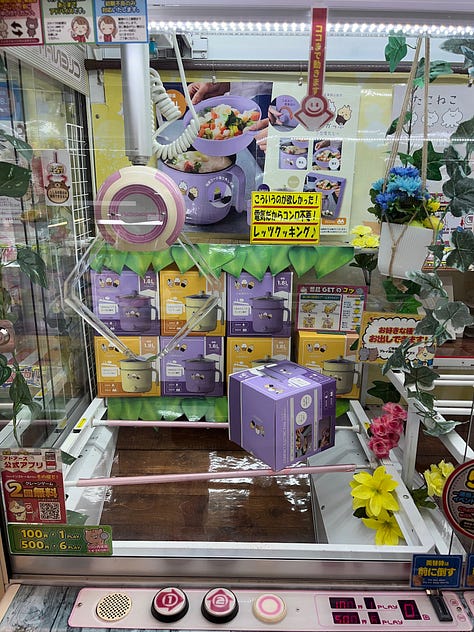

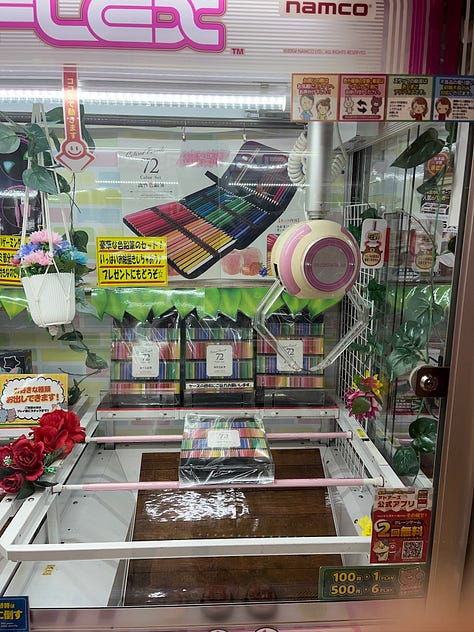
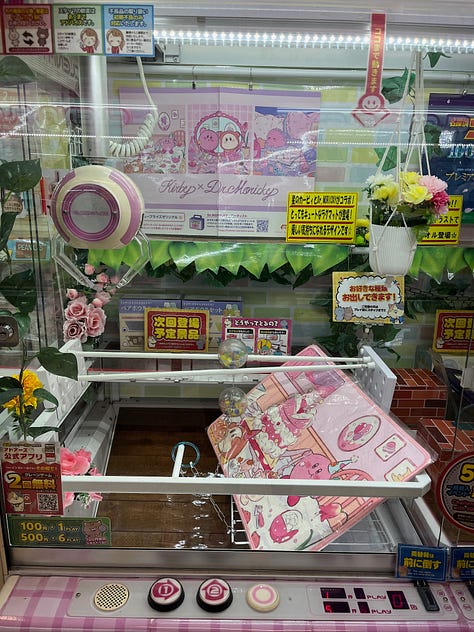
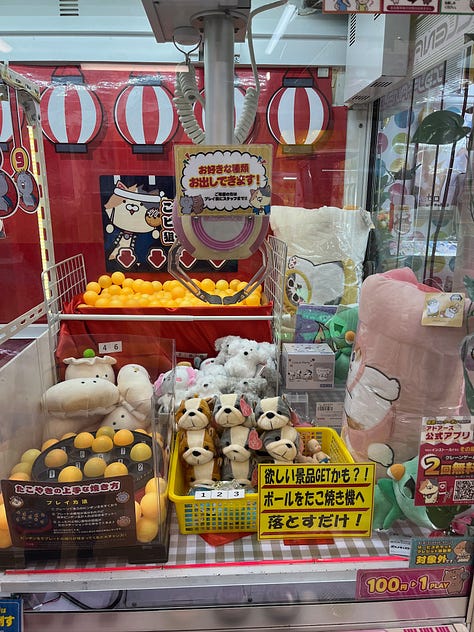
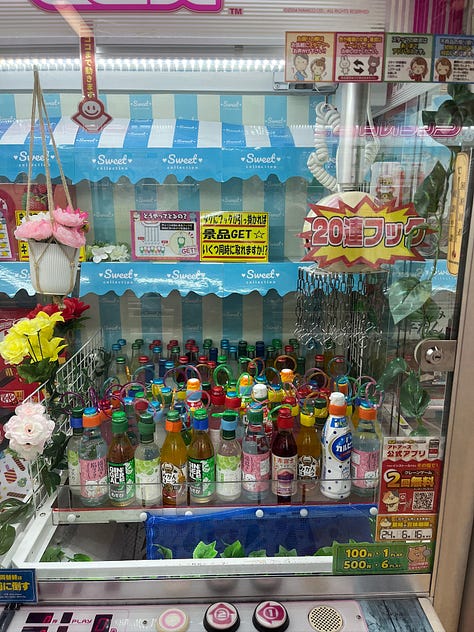
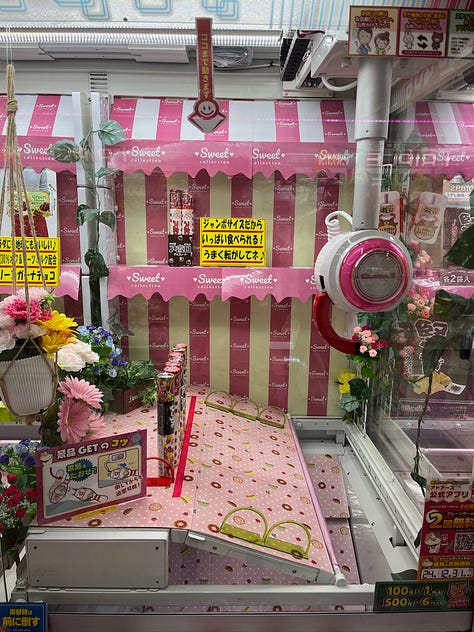
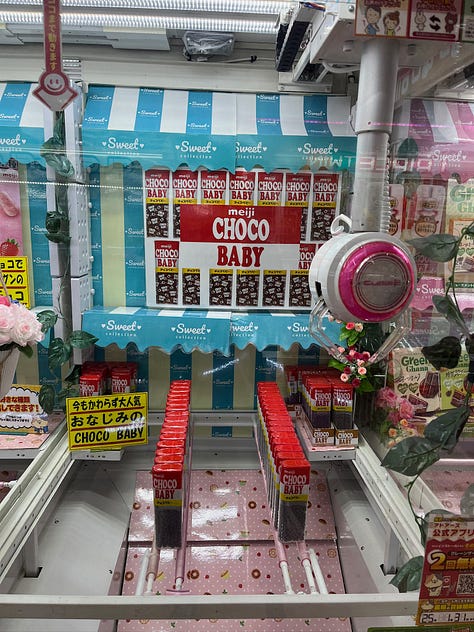
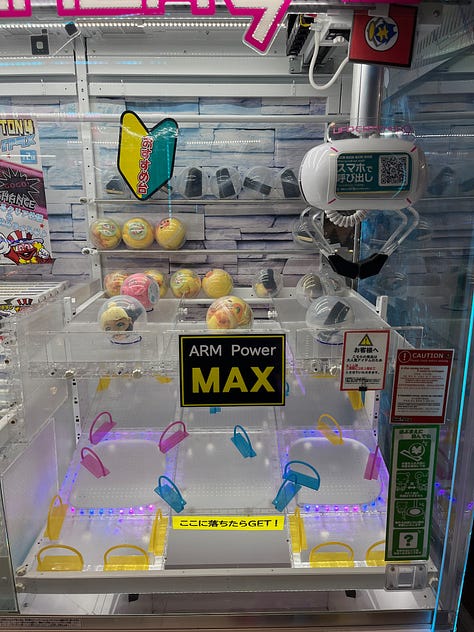
(From the top left to bottom right) Use the claw to:
Push the prize towards the left where there’s a larger gap/hole for the prize to drop through
Gradually change the angle of the prize held together by the poles to fall through
Use the claw to adjust the prize sideways to it falls through
Push the ball out of the through the poles. The ball holds up the prize, so when the ball falls off the prize is released and dropped.
Pick up ping pong balls to get the right combination of numbers in the bowl. The prize you get depends on the combination of numbers you get in the bowl.
Hook the rings fastened on top of the bottles to win drinks
Knock over candy containers with a modified half-claw
Pick up and knock off candy containers
Pick up a ball and drop it into a lower level. The ball needs to roll correctly into the prize slot, otherwise it’ll get blocked by the colored barriers
Many of these claw game variants required some sort of sunk cost. It’s impossible to get an items through those poles in one shot no matter how skilled the player is. And someone gives up or runs out of money halfway through, someone will swoop in for the kill. Speaking from personal experience on this one.
Again, this is just a small sample of the variations of the claw game that I saw. I personally haven’t seen this in the US yet, although I wouldn’t be surprised if they eventually make their way overseas to the local Dave & Buster’s. Then parents can put bets on whether the kids win these claw games on steroids 😂
Gacha
Similar to the claw game, Asia takes this to a whole different level and people actually want to get the stuff in the machine.
Just to give you an idea of how prevalent gacha is in Japan, this was at Narita airport upon landing.
Because gacha is such a large part of consumer and collectible culture in Japan, there were certain machines that were exclusive to certain locations or seasonally oriented.
What caught my eye in the gacha scene was the higher-end themed machines.
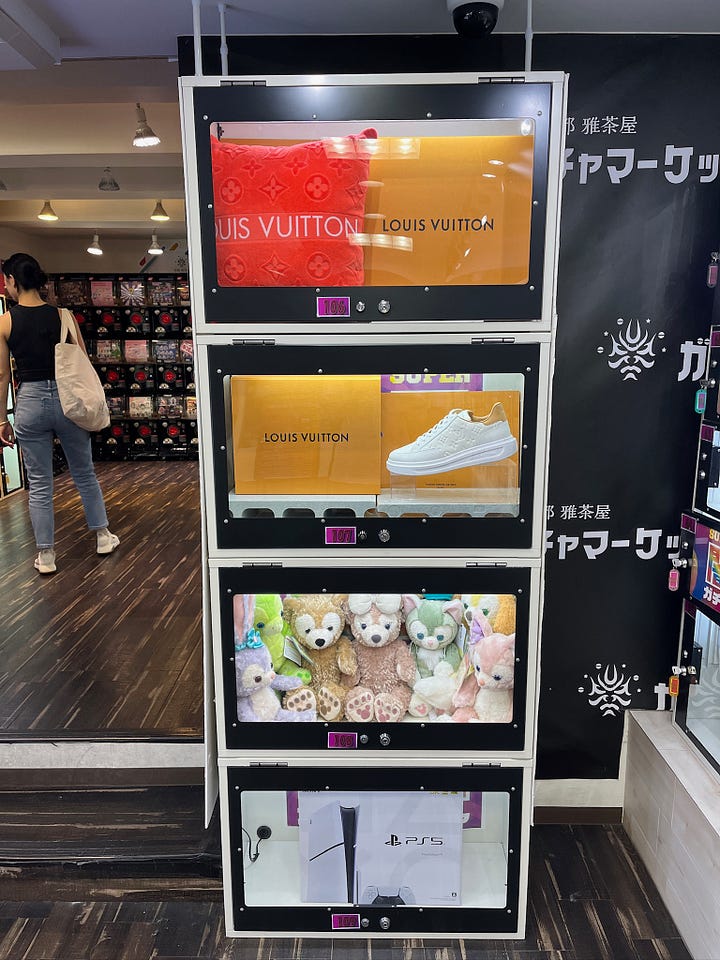

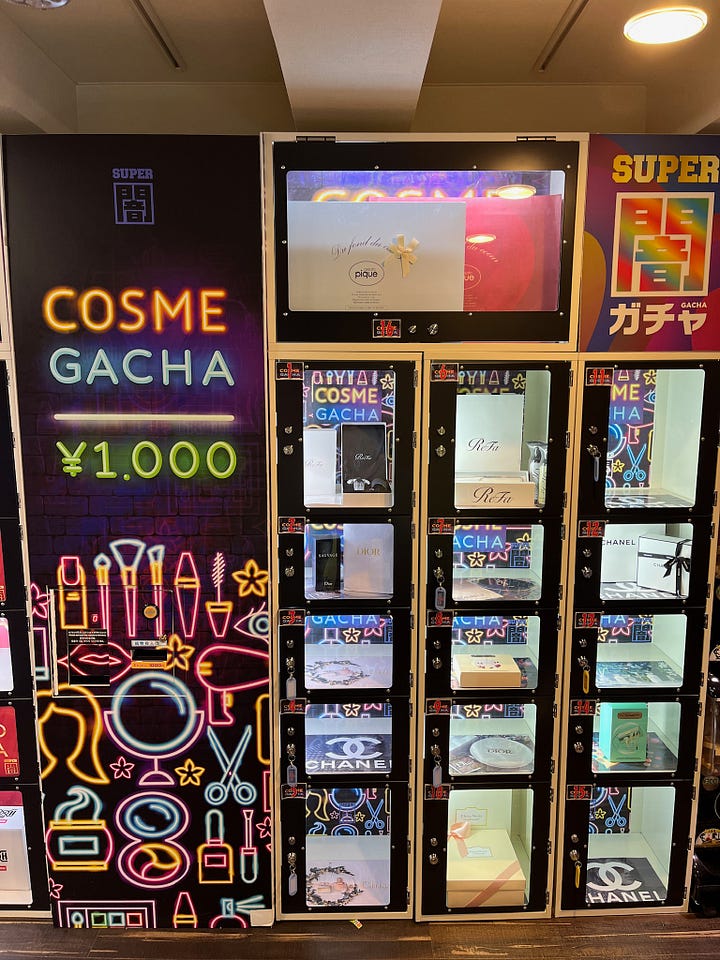
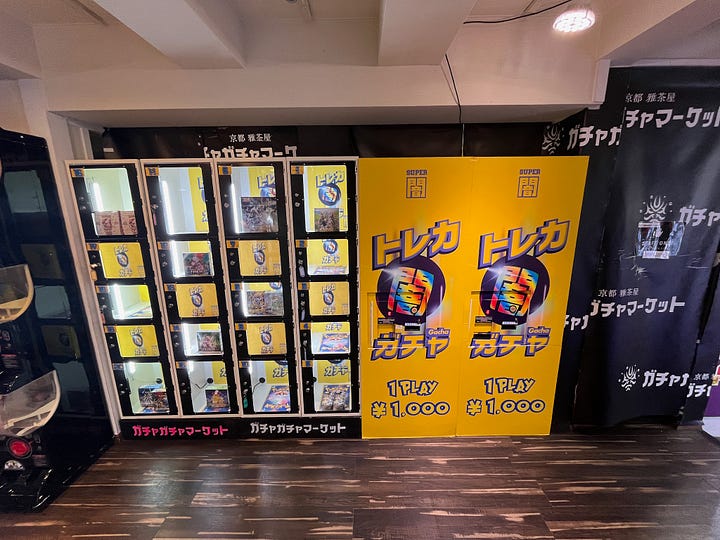
(From the top left to bottom right) These premium gacha machines focused on:
High-end items like Louis Vuitton, a bundle of plushies, and a PS5
Supreme items as a theme
Cosmetic items from luxury brands like Chanel, Dior, and Chloe as a theme
Pokemon figurines as a theme
These machines also incorporated a standard gacha/blind box mechanic. You know what the available prizes are, but you don’t know the odds of winning. And if you win something, you don’t know the odds of winning a specific item.
Putting it all together
Although it may seem like there isn’t a point in me sharing all these mini-game observations, there is:
‘Gambling’ exists everywhere
Whether it’s sports betting, pachinko, premium gacha, or taking a leveraged trade on Bitcoin, it’s everywhere and creeping into everything for better and worse. It might be called something else, but these all have similar traits and play upon the same psychology. It’s sorta like ice cream vs. gelato vs. ice cream bars, vs. popsicles. They’re not the same and sorta are if you take a step back.
Sidebar: On the note of food comparisons, it reminds me of The Cube Rule, which is an interesting concept and the breakdown gets progressively ridiculous/hilarious
Regional differences and novelty
There are definitely opportunities for reskinning something like pachinko to be more culturally appetizing. And for the claw game and gacha on steroids, that probably doesn’t even need to be reskinned, just ported over.
With crypto and web3, what’s old is new since blockchain enables new models of incentivization, interaction, and interoperability — Maybe this is where pachinko as a gaming mechanic finds a wedge to a larger audience (not that it has to, just a fun thought exercise).
For those based in Asia, these observations might make you yawn. Been there, done that. Nothing new to see here.
Which is exactly the point! What’s boring and overplayed in one part of the world is novel and fresh elsewhere. And putting these things on the blockchain have the potential to make them novel and fresh, everywhere (if done in a tasteful way).
Reforming, remixing, and refreshing
Each of these games I pointed out started out with a simple mechanic and has since evolved in some way.
Reforming (Pachinko): The game started out something sorta similar to pinball, but has since incorporated slot machine mechanics as the game added digital displays.
Remixing (Claw game): The claw game examples I presented all had the same mechanic with the environment itself being modified whether it’s the poles, removing half the claw, or adding another level to the box.
Refreshing (Premium gacha): The premium gachas gave a makeover to the traditional look with bright colors, big boxes, and higher value prizes.
This not only provides some inspiration for how traditional mechanics (gaming, engagement, etc.) can evolve, as well as how blockchain can scale that potential even further. And of course, I hope this will go beyond gambling and speculation.
See you next week!






